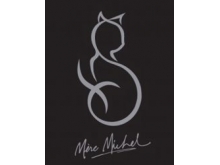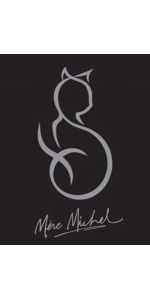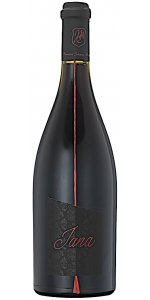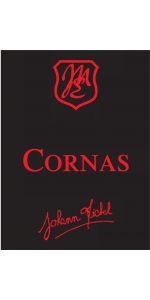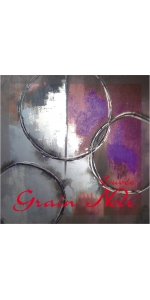Johann Michel Cornas Cuvee Mere Michel 2016
| Country: | France |
| Regions: | Rhone Cornas |
| Winery: | Johann Michel |
| Grape Type: | Syrah |
| Vintage: | 2016 |
| Bottle Size: | 750 ml |
Johann Michel Cornas Cuvee Mere Michel is made from 100 percent Syrah.
Cuvee Mère Michel was first introduced in 2016 and is not produced every year. This wine is a tribute to Johann Michel' wife, Emmanuelle, and a nod to the French song, La Mere Michel. This wines comes from Selection Massale (replanting new vineyards with cuttings from exceptional old vines from the same property) cuttings of Serine off the 1947 Yves Cuilleron vineyard at Chavanay. The vineyards are located in the lieu-dit "Les Cotes" at an altitude of 230 meters and benefiting from a southern sun exposure.
Review:
"Only made in top vintages, the 2018 Cornas Mère Michel is a tribute to Johann's wife and a play on the French song "La Mere Michelle." Brought up in a new demi-muid, it's a richer, broader wine compared to the Cuvée Jana yet still has incredible Cornas style in its red, black, and blue fruits as well as notes of toasted spice, roasted meat, chocolate, and wild herbs. Rich, full-bodied, and opulent, it has a touch more upfront appeal and should be drinkable in just 4-5 years yet also evolve for two decades." -
Jeb Dunnuck (Northern Rhône: The 2018s and 2019s, November 19th 2020), 98 pts
Johann Michel Cornas Cuvee Mere Michel is made from 100 percent Syrah.
Cuvee Mère Michel was first introduced in 2016 and is not produced every year. This wine is a tribute to Johann Michel' wife, Emmanuelle, and a nod to the French song, La Mere Michel. This wines comes from Selection Massale (replanting new vineyards with cuttings from exceptional old vines from the same property) cuttings of Serine off the 1947 Yves Cuilleron vineyard at Chavanay. The vineyards are located in the lieu-dit "Les Cotes" at an altitude of 230 meters and benefiting from a southern sun exposure.
Review:
The tiny production 2022 Cornas Mère Michel is 100% Serine that was not destemmed and was aged 14 months in French oak. Tighter and more focused, this beautiful wine reveals ripe red and blue fruits that give way to more spice, leather, graphite, and mineral notes. More medium to full-bodied, with a firm spine of tannins, it's impressive but will need time.
-Jeb Dunnuck 94 Points
Johann Michel Cornas Cuvee Jana is 100% Syrah.
Black raspberry aromas, licorice, sizzled bacon and smoke. Elegant and pure with depth and well-integrated tannins.
Jana is the name of Johann and Emmanuelle's daughter.
Manual harvest, selection of the grapes from the "Chaillot" parcel, full clusters, fermentation in tanks for 3 weeks, daily remontage and pigeage. Malolactic fermentation in oak barrels and aging on the lees for 12-18 months in barrels (new old barrels) The average age of the vines is 11 years. Yield: 25 hl/ha
Review:
"Dark purple. Highly perfumed, oak-spiced black and blue fruits, incense, vanilla and potpourri on the hugely perfumed nose, along with hints of licorice, smoked meat and mocha. Stains the palate with concentrated, spice-laced blueberry, cassis, cherry-vanilla and espresso flavors that turn sweeter as the wine opens up. Broad, polished tannins add shape to a strikingly long, smoke- and spice-driven finish that strongly echoes the floral and blue fruit notes. - Josh Raynolds"
- Antonio Galloni's Vinous (December 2022), 97 pts
Johann Michel Cornas is 100% Syrah
This Cornas is a blend from 2 different vineyard sites:
- 60% of the final blend is from vineyards located on a hillside (16 year old vines on the "coteau"), planted on sandy soils, decomposed granite and some rocks, giving the structure, spiciness and licorice flavors to the blend.
- the other 40% of the final blend comes from the bottom of the slope (40 years old vines on the "pied de coteau"), planted on sandy soils, bringing acidity and balance to the wine.
Expressive, deep, rich, silky and juicy. Well structured and round, it displays red fruit, leather, black cherry, liquorice and black berry aromas.
Review:
"Bright and intense both in color and in aroma. Hyper-fresh, searching berry fruits, this is electric. Rounded, with plump berry fruits that are concentrated and fresh. The tannins are intense too, grippy and strict on the long finish. This is almost painful to taste at this stage, but should be excellent in time. Vines with an average of 35 years of age, from lieux-dits Saveaux, Patou and Les Côtes, all destemmed and then aged in two- to five-year-old demi-muids. - Matt WALLS"
- Decanter (Rhone 2021 en primeur, October 1st 2022), 96 pts
Johann Michel Cornas is 100% Syrah
This Cornas is a blend from 2 different vineyard sites:
- 60% of the final blend is from vineyards located on a hillside (20 year old vines on the "coteau"), planted on sandy soils, decomposed granite and some rocks, giving the structure, spiciness and licorice flavors to the blend.
- the other 40% of the final blend comes from the bottom of the slope (45 years old vines on the "pied de coteau"), planted on sandy soils, bringing acidity and balance to the wine.
Expressive, deep, rich, silky and juicy. Well structured and round, it displays red fruit, leather, black cherry, liquorice and black berry aromas.
Review:
"Ripe black and blue fruits, violets, sappy herbs, and iron notes all emerge from the 2022 Cornas, a pretty, pure, medium to full-bodied Cornas offering fine, ripe tannins, a balanced, layered mouthfeel, and a great finish. The 2022 was completely destemmed and spent 12 months in oak."
- Jeb Dunnuck (Importer Highlight: Fran Kysela ; July 2024), 93 pts
Johann Michel Cuvee Grain Noir is made from 100 percent Syrah
This is delicious. Expressive, deep, rich, silky and juicy.
Well structured and round, it displays red fruit, leather, black cherry, liquorice and black berry aromas.
This Cornas is a blend from 2 different vineyard sites:
- 60% of the final blend is coming from vineyards located on the hillside (16 year old vines on the "coteau") which is planted on sandy soils, decomposed granite and some roicks, giving the strucutre, the spiciness and the licorice type of flavors to the blend.
- the other 40% of the final blend is coming from the bottom of the slope (40 years old vines on the "pied de coteau") which is planted on sandy soils, bringing acidity and balance to the wine.
Manual harvest, selection of the grapes, 100% destemming, fermentation in tanks for 3 weeks, daily remontage and pigeage.
Malolactic fermentation in oak barrels and aging on the lees for 12-18 months in barrels (2 to 4 year old barrels)
Review:
"Inky ruby. An explosively perfumed bouquet evokes ripe red and dark berries, licorice, exotic spices and incense, along with a strong, smoky mineral overtone. Stains the palate with sweet, sharply delineated black raspberry, boysenberry, violet pastille and spicecake flavors that become more lively with air. Displays a compelling marriage of richness and finesse and finishes extremely long, seamless and precise, with smooth tannins coming in late. - Josh Raynolds"
- Antonio Galloni's Vinous (April 2018), 94 pts
The Domaine Johann Michel Estate
Johann Michel is a self-taught winemaker who discovered his passion while tasting old bottles of wine with his grandfather. His first vintage was 1997. He works alongside his wife Emmanuelle, farming a little over 5.5 hectares (13.5 acres) spread between three AOC’s:
- 4 hectares are in Cornas, all farmed under "culture raisonnée" (sustainable method), in the lieux dits "Les Côtes", "Bayonnet", "Chaillot" and the parcel called "Saveaux" for the AOC Cornas. Yields are very low here – 33 hl/ha for Cornas Tradition and 25 hl/ha for Cuvee Jana. He also produces a special cuvée, only in certain years: “Cuvée de la Mère Michel”, a tribute to his wife & a play on the French song “La Mere Michelle”.
AOC Cornas is one of the smallest AOC’s in France (only 116.4 hectares; 287 acres) - 0.37 hectares in Saint Joseph AOC. Planted only with Syrah, Johann’s first vintage was 2016 with 700 bottles produced. The vineyard is 120 meters high in altitude with a density of the density of 4,400 vines per hectare. The Saint Joseph wine is made using 100% destemmed grapes.
Saint Joseph AOC is quite large compared to Cornas AOC, with a total acreate around 920 hectares (2,270 acres). The quality of the soils can be very different from one part to the appellation to another part of the AOC. - 1 hectare in Saint Peray, planted with Marsanne and Roussanne. His parcels are located at the extreme South of the Saint Peray AOC (a few meters away from the border with the Cornas AOC). Johann makes 2 cuvées of Saint Peray: Saint Peray Blanc (a blend of 50% Roussanne and 50% Marsanne), and Saint Peray Blanc Cuvée M (100% Marsanne).
- back
The Stone Corral Vineyard is planted on a southeast slope on the west side of the Edna Valley which has an east/west orientation opening up to the Pacific Ocean from Morro Bay and Pismo Beach. Approximately 120 to 300 feet above sea level, the climate is strongly influenced by the ocean providing ideal temperate growing conditions for Pinot Noir. Early spring warming, mild summer temperatures and late arriving cold fall temperatures and rain provide a long growing season for the development of rich color, concentrated and complex flavors. Soil profiles vary between blocks from sand, sandy loam, loamy sand, pebbly sandy clay loam, all fine angular blocky , including decomposing sandstone layers and numerous fossil rocks. The soils are well drained and marine in origin, resulting in an elegant Pinot Noir with extraordinary attributes.
This gem is a blend of a few precious, select barrels hailing from the finest blocks of Stone Corral Vineyard. Offers blue-toned fruit on the nose and a pretty bouquet of black raspberry, sandstone, marzipan and wild lupine flowers. Opulent, yet delicate on the palate, with velvety layers of cola nut, cherry, dried herbs and pecan sandie cookies.
Wine analysis – 13.7% Alcohol, .69 TA, 3.5pH
- A barrel select Stone Corral Vineyard bottling, utilizing the finest blocks and clones of the 2013 vintage
- Blend of clones 115, 777 and 667 on 101-14 and 3309 rootstalks
- Hand harvested, cold fruit from night picks during the month of September 2013
- Yield about 2 tons per acre between 23.8 and 24.5 ° Brix
- Destemmed with nearly 100 % whole berries remaining
- Fermented in small open top tanks
- 4 day cold soak, average 14 day fermentation, peak temperature 83°
- Hand punched down several times daily as needed
- Pressed off just dry, tank settled then racked to barrels
- Aged in small French oak barrels for 18 months
- Once the fresh wine is transferred from the press pan, all moving of the wine is done with inert gas pressure.
When handling the wine, care is taken at all opportunities to avoid shear.
"This bottling comes from the best blocks and barrels from this single vineyard, co-owned by a number of Edna Valley luminaries. The result is stunning, with baked raspberry, strawberry, maple, and peppery bacon aromas comprising a spicy, exotic nose. Black plum fruit melds with white pepper and crushed herbs, diving into tangy strawberry and sandalwood incense notes on the finish. - Matt Kettmann"
- Wine Enthusiast Magazine (April 1st 2017), 95 pts
Hugl Zweigelt Classic is made from 100 percent Zweiglt.
Despite its relative youth, Zweigelt is actually an Austrian classic. This variety was created in 1922, when Dr. Fritz Zweigelt crossed two grapes - St Laurent and Blaufränkisch. Originally, it was intended for the new variety to be called Rotburger, referring to the place where it was born, Klosterneuburg. But this name never took hold, and instead, Zweigelt was named after the man who was the key in its development.
Today, Zweigelt is the most widely planted red variety in Austria, growing in nearly 9% of this country's vineyards. It is a robust grape, highly resistant to dryness, frost and various diseases.
The wine boasts a concentrated color, fruity and spicy aromas, cherry flavors. Full-bodied, smooth and round, the wine is an ideal food companion.

